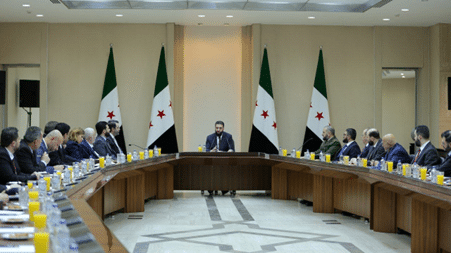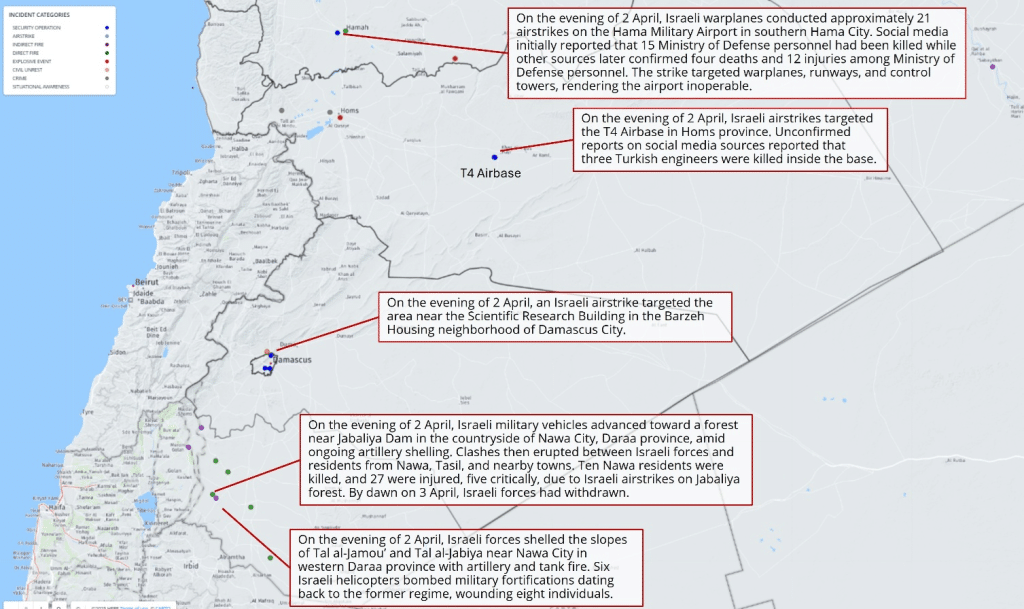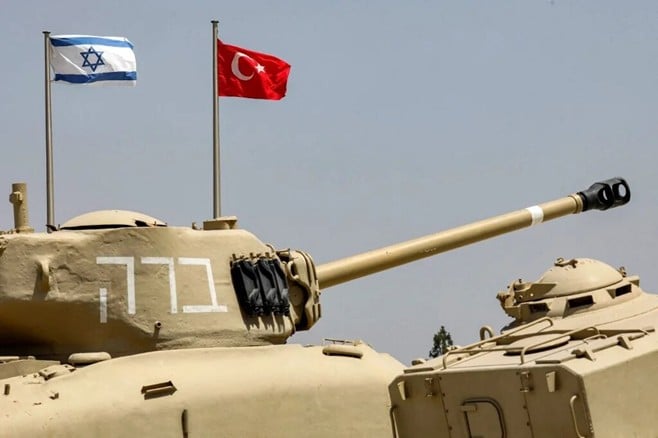Weekly Incident Map
Dear subscriber. Welcome to the Syria Weekly Report – a brand-new reporting service launched by Talos that provides high-quality information and analysis on Syria. The report is focused on broader strategic and political developments in the country, as well as Syria’s relations to regional stakeholders and surrounding countries. The report is disseminated every wednesday and is complemented by a daily report.
The service will be provided for our existing subscribers for free for a limited time period and then offered as a separate, stand-alone product outside your regular subscription. For inquiries regarding prices for a subscription, or the availability of bespoke reporting on Syria – including in-depth reports, risk assessments and incident data – please email [email protected]. Please also contact us if you are interested in transportation or other security services in Syria. In the meantime, please enjoy this complimentary service.
Executive Summary
-
Israel intensified airstrikes and operations
-
Domestic and regional reactions to Israeli operations
-
Airstrikes provoke increase in Turkey-Israeli tensions amidst Turkish deployments
-
President al-Sharaa chairs first cabinet session as SDF exchange prisoners
-
IS activity increases in eastern Syria
Israel intensified airstrikes and operations
Dominating developments this week were an intensification in Israeli airstrikes and ground operations in the southern and central regions of Syria, including in Damascus and the surrounding countryside. Beginning on 2 April, a large number of airstrikes were conducted by Israeli fighter jets in Damascus City, Homs, and Hama provinces – all targeting warehouses, military sites and airbases. In Damascus, the strikes on 2 April targeted an area near the Scientific Research Facility in the Barzeh neighborhood as well as the Qutafay area in Damascus province. Airstrikes also targeted the T4 airbase in Homs province and at the Hama Military Airport, with local sources documenting approximately 30 separate operations in total. Security sources stated that the airport was “completely destroyed” as a result, and rendered not operational following the airstrikes. The casualty figures were subject to conflicting reporting but the Syrian Observatory for Human Rights said four individuals were killed and 12 injured, however conflicting reports claim more than 10 were killed.
The Israel Defence Forces (IDF) later confirmed the operation and said airstrikes targeted two airports in Syria, targeting “remaining military capabilities” at the Hama airport, T4 airbase and “military infrastructure” in Damascus. Commenting on the operations, Israeli Defence Minister Israel Katz described the strikes as “a clear message and a warning for the future – we will not allow the security of the State of Israel to be harmed”.
Additional operations were conducted on 3 April in Damascus and Daraa provinces. In Damascus, media sources reported that Israeli warplanes launched airstrikes targeting military positions affiliated with the First Division near the city of Kiswah in the western countryside of Damascus, as well as the 75th Brigade in the town of Muqaylibah in the Damascus countryside. No information was released regarding the extent of human or material losses. On the same day, multiple sources reported that Israeli airstrikes targeted the Tasil Dam Forest (National Park) and the vicinity of Tal al-Jumu’ between the cities of Nawa and Tasil in the western countryside of Daraa Governorate. The strikes killed at least nine local militants attempting to repel advancing Israeli forces. Syria’s Ministry of Health later revised the death toll to ten and reported 27 wounded, however these figures were also subject to conflicting reports.
Further to the airstrikes, an escalation in ground activity was also noted over the week in the southern provinces where clashes broke out between Israeli forces and armed elements on 3 April near Nawa city in Daraa province. The Israeli military’s version stated that its forces launched an “infiltration operation” to confiscate weapons and terrorist infrastructure” and that armed elements opened fire during the operation. The Israeli force “responded with fire and killed several armed terrorists from the ground and air,” the IDF said on its official channel on social media platform.
The local authorities provided a different version of the events and stated that nine “civilians” were killed during a raid by Israeli forces. In response, local residents reportedly mobilized to resist the Israeli side, with clashes breaking out as a result near Nawa, Tasil, and nearby towns in western Daraa. The same reports, citing residents, claimed Israeli airstrikes were conducted in conjunction with Israeli artillery strikes against the villages affected. While casualty figures remain unclear, local sources stated that ten residents were killed as a result, and more than 20 injured and that Israeli forces withdrew from the area in the early hours of 3 April.

Demonstration against Israel in Damascus
Domestic and regional reactions to Israeli operations
The reactions to these operations were predictably negative and regional countries again expressed their strong condemnation of Israel’s continued infringement of Syrian territory. As expected, close allies including Turkey, Saudi Arabia, and Qatar were quick to condemn the Israeli airstrikes on 3 April, as did other member states of the Gulf Cooperation Council. Similarly, Jordan, Egypt and Lebanon also released statements to denounce Israel’s escalation. Several Western countries also expressed criticism, with the German Foreign Ministry urging Tel Aviv to halt operations as did the UK Foreign Ministry. UN Special Envoy for Syria Geir Pedersen echoed these concerns, warning that continued escalation undermines efforts toward political resolution and peace. Domestic reactions were also noted over the week, as protests condemning Israel were recorded in various cities to denounce both the operations in Israel and the situation in the Gaza Strip. These included gatherings in Damascus city and province, as well as in the southern region, Aleppo, Homs and Hama provinces.
Airstrikes provoke increase in Turkey-Israeli tensions amidst Turkish deployments
The airstrikes this week represent one of the most significant escalations in Israeli operations within Syria since the fall of the Assad regime, and the casualty figures discussed are likewise higher than in previous episodes. Like prior operations, the Israeli military aims to neutralize assets used by the previous government in an effort to degrade the interim government’s ability to mobilize conventional capabilities that may eventually pose a threat to Israel. This is assessed to be part of, and consistent with, a broader Israeli strategy to maintain weak neighbors militarily. When it comes to Syria, the most specific objective is to prevent the HTS-led government from utilizing these assets in the future and to grow its conventional military capabilities, which at present remain limited.
The timing of the strikes is also noteworthy amidst reports of Turkish plans to deploy assets to central Syria, as part of an effort to enhance strategic cooperation with the interim government, protect related military assets and expand Turkey’s influence and military presence in the country. According to media reports this week, the plans encompass the Tiyas Airbase (T4) in Homs, where air defense systems are set to be deployed at the base. The same sources claim the plans include the deployment of the Hisar-type air defense systems as well as unspecified surveillance and UAV capabilities, including combat variants with extended strike capacities to counter various aerial threats. Separate Syrian sources state that similar plans exist to entrench Turkey’s presence in the Menagh Airbase, near the Syria-Turkey border in Aleppo Province. The same source added that this would include the deployment of Turkish fighter jets and other aerial capabilities designed to protect the bases from external threats.
When these assets are planned to be deployed remains unclear, but limited reports this week suggested that Turkish engineers were present at the T4 base when it was targeted on 2 April. Additional reports stated that Prime Minister Netanyahu ordered these sites to be targeted before Turkish assets were deployed – at which point the base would be off limits for Israeli operations. This directive, combined with Turkish and Israeli rhetoric suggesting efforts to establish deconfliction mechanisms and pledges to avoid a confrontation, indicates an intent on both sides to reduce the risks of a conflict.
That said, Turkey’s expansion amidst Israel’s continued operations forms a cause for concern and sets conditions for an increase in strategic tensions between the two sides that will likely shape developments over 2025. The rhetoric between the countries has certainly intensified, with Israel accusing Turkey of attempting to turn Syria into a Turkish “protectorate”. For their part, the Turkish Foreign Ministry last week called Israel the “greatest threat to regional security” and although both sides later confirmed that deconfliction mechanisms are in place to avoid any accidental confrontations, related tensions are expected to remain and form a potential threat indicator over the short to medium term.
President al-Sharaa chairs first cabinet session as SDF exchange prisoners
Interim President Ahmed al-Sharaa chaired his first session this week (on 7 April) of the cabinet formed on 30 March. Syrian state-linked sources stated that the session focused on the reconstruction effort, investments in infrastructure, economic revitalization and national unity. The president instructed his ministers to draft and then present “detailed action plans” at the next cabinet meeting to facilitate the implementation of the government’s efforts to move forward with plans. Regarding national unity, al-Sharaa also emphasized the need to rebuild the national army and to integrate the Suwayda-based militia faction as well as the Syrian Democratic Forces (SDF) into the formal structures of the new government. To recall, this follows agreements reached in March with both the SDF and the Suwayda Military Council to integrate these forces, however details of the integration remain to be determined and negotiations are still ongoing regarding their implementation.

President al-Sharaa chaired first session of new cabinet
In a related development, the SDF and interim government reached an agreement on 1 April to transfer security responsibilities in Aleppo and exchange prisoners. Both sides then proceeded to carry out parts of the agreement during the week, with the first batch of prisoners exchanged on 3 April. The next day, units of the SDF affiliated with the YPG (PKK’s branch in Syria) proceeded to withdraw from areas around Aleppo. A second prisoner exchange was conducted the next day and on 9 April, some 500 SDF members withdrew from the Kurdish-majority neighborhood of Sheikh Maqsood and Ashrafiyeh in Aleppo. Under the terms of the agreement, the Assayish forces will remain deployed in these areas but remain under the control of the Democratic Autonomous Administration of North and East Syria (DAANES) yet restructured as “public security forces” – a security branch that falls under the Ministry of Defence.
The agreement has so far been implemented without major setbacks and forms a positive indicator for the broader security and stability in the northeast. The agreement has also raised hopes and expectations for a wider, nationwide ceasefire and this week SDF Commander Mazloum Abdi said these efforts are underway under international mediation. The SDF-HTS agreement does not encompass Turkish-backed factions but conflict activity between the SDF and the Turkish-backed Syrian National Army has visibly declined, with limited frontline activity noted over the review period. That said, reports of isolated clashes continue while media sources affiliated with opposing sides continue to accuse each other of conducting various activities. Pro-Turkish sources accused the SDF of “shelling” civilian residencies during the week and continue to disseminate reports of forced abductions and arbitrary arrest operations that lack credible verification. Meanwhile, pro-SDF sources claim Turkish artillery and airstrikes were conducted near the Tishreen Dam and other areas along the frontline in eastern Aleppo and Raqqa provinces.
IS activity increases in eastern Syria
IS activity levels showed signs of increasing this week, with multiple attacks recorded in the Deir ez Zour and Hasaka provinces. On the morning of 3 April, several media sources reported that a Syrian Democratic Forces (SDF) checkpoint between the town of Hawaij and the city of Shuhail in Deir ez Zour Governorate was attacked with machine gun fire by unknown gunmen. No injuries were reported, and the assailants fled the area. Later, the General Command of the Internal Security Forces in North and East Syria reported that IS-affiliated cells launched an attack using a motorcycle on a checkpoint in the town of Dhiban, injuring one security member. The forces responded by engaging the attackers and launching intensified patrols and search operations in the area.
Another suspected IS attack was also reported in the Deir ez Zour province on the same day. Media sources reported that unidentified gunmen targeted the home of Abdul Karim Awad Al-Ahmad, the owner of a money transfer office, in the town of Tayyana in eastern Deir ez Zour countryside. The attack followed Al-Ahmad’s refusal to pay money to the assailants despite repeated threats. The incident caused material damage, but no casualties were reported. Later sources attributed the attack to Islamic State elements. Additional attacks targeting checkpoints and single individuals were later recorded in Abu Khashab, Hawaij, and Shuhail in the province, including one attack that local sources said involved the use of rocket-propelled grenades. One of the attacks targeted a security checkpoint and prompted a security response that provoked localized clashes as well.
Further to these incidents, other sources also noted an increase in attack activity by IS. The Syrian Observatory for Human Rights (SOHR) – a generally reliable source but that has a tendency to exaggerate casualty figures and details of specific incidents – claimed IS conducted four attacks within 72 hours in the Deir Ez Zour province between 4 and 6 April. The same source said it documented 53 attacks by IS since the beginning of 2025, resulting in 13 fatalities amongst SDF elements and civilians in the northeast. These figures are slightly higher than those recorded by Talos and are assessed to include suspected, but unconfirmed attacks that are questionably attributed to IS. Regardless, the recent increase in attack activity is clear and is set to raise concerns about a possible IS resurgence in the country amidst continued security gaps.
It is worth noting however that the attack activity seen in recent weeks has been limited to hit-and-run style attacks that require little sophistication. With the exception of a reported RPG attack, the assaults involve small-arms fire and are not assessed to represent any deviation from established IS capabilities. The majority of attacks this year have also targeted checkpoints and security patrols, as opposed to civilians, and with the exception of an attack plot in Damascus in January, the group has stayed clear of targeting (or attempting to target) civilian gatherings, religious sites and other targets that would generate a more significant impact.
That said, the activity levels form a consideration amidst continued speculation over the US presence and the potential impact of a withdrawal. The Trump administration has yet to communicate any clear decisions or intent on the matter, fuelling concerns that a pullout would facilitate a more significant resurgence. The primary threat consideration involves the thousands of IS fighters detained in prisons and refugee camps which remain an attractive target for IS breakout efforts. With approximately 10 thousand fighters and over 40 thousand family members kept in these camps, it is assessed as likely that the group will at some point attempt to free these members similar to the attempts made in 2023 and 2024.
Damascus Weekly Map
Control of Terrain Map – April 2025






